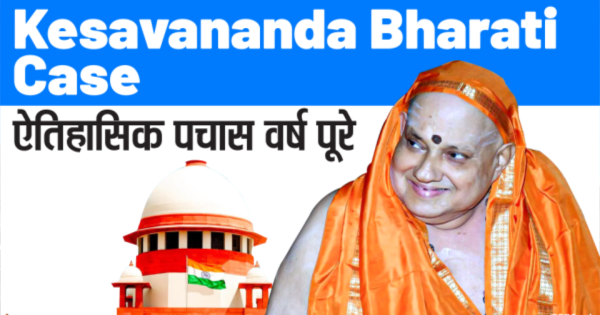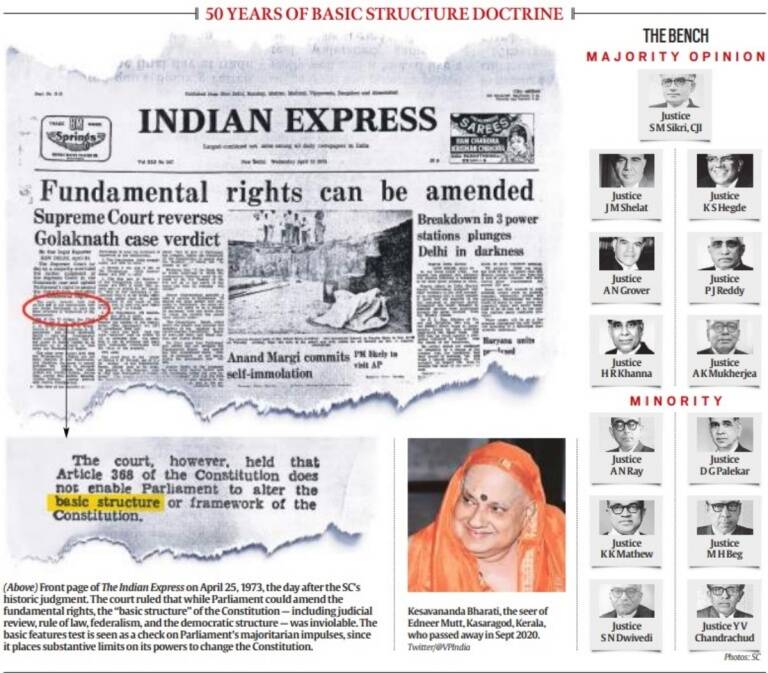On Monday, the Supreme Court will mark the 50th anniversary of its important judgment in Kesavananda Bharati, in which it established the “basic structure” concept on the limits of Parliament’s power to modify the Constitution. The basic structure theory has been regularly challenged over the years for weakening the principle of separation of powers and eroding Parliament’s authority, as well as for providing a vague and subjective form of judicial review.
50 Years Of Kesavananda Bharati Case
Why In The News?
- The Historic Ruling In Kesavananda Bharati, In Which The Supreme Court Laid Down The “Basic Structure” Doctrine On The Limits Of Parliament’s Power To Amend The Constitution, Completes 50 Years On 24th April 2023.
- Over The Decades, The Basic Structure Doctrine Has Been Criticised Repeatedly For Diluting The Principle Of Separation Of Powers And Undermining The Sovereignty Of Parliament, And As A Vague And Subjective Form Of Judicial Review.
Who Was Kesavananda Bharati?
- Kesavananda Bharati Was An Indian Hindu Monk Who Served As The Shankaracharya (Head) Of Edneer Mutt, A Hindu Monastery In Kasaragod District, Kerala, India From 1961 Until His Death In September 2020.
What Was His Petition About?
- He Challenged The Kerala Land Reforms Legislation In 1970, Which Imposed Restrictions On The Management Of Religious Property. The Case Was Challenged Under Article 26, Concerning The Right To Manage Religiously Owned Property Without Government Interference.
- A 13-Judge Bench Was Set Up By The Supreme Court, The Biggest So Far, To Hear The Case. The Main Issue Discussed Was Regarding The Power Of Parliament To Amend The Constitution Unlimited Even To The Extent Of Taking Away All Fundamental Rights.
Background For The Case
- In The Shankari Prasad Case (1951) And Sajjan Singh Case (1965) – SC Said Parliament Had The Power To Amend Any Part Of The Constitution.
- In Golaknath Case (1967), The Supreme Court Held That Parliament Could Not Amend Fundamental Rights, And Power To Amend The Constitution Would Be Only With A Constituent Assembly.
- To Disaffect The Judgments Of The Supreme Court In The Golaknath Case (1967), RC Cooper Case (1970), And Madhavrao Scindia Case (1970), The Then Government Enacted Major Amendments To The Constitution. Most Notably:
- 24 Constitutional (Amendment) Act, 1971- Parliament Had Also Given Itself The Power To Amend Any Part Of The Constitution.
- 25 Constitutional (Amendment) Act, 1972- The Right To Property Had Been Removed As A Fundamental Right.
Verdict In The Kesavananda Bharati Case
- It Was On 24th April 1973 The Landmark Judgment Was Delivered By The Indian Supreme Court With A Thin Majority Of 7:6 Wherein The Majority Held That Any Provision Of The Indian Constitution Can Be Amended By The Parliament.
- In Order To Fulfil Its Socio-Economic Obligations That Were Guaranteed To The Citizens As Given In The Preamble, Provided That Such An Amendment Did Not Change The Constitution’s Basic Structure.
- The Court Held That The 24 Constitutional Amendment Was Entirely Valid. But It Found The Second Part Of The 25 Constitutional Amendment To Be Ultra Vires. The Supreme Court Declared That Judicial Review Is A Basic Structure And Hence Cannot Be Taken Away.
- Despite The Ruling That Parliament Cannot Breach Fundamental Rights, The Court Upheld The Amendment That Removed The Fundamental Right To Property. The Court Ruled That In Spirit, The Amendment Would Not Violate The “Basic Structure” Of The Constitution.
Doctrine Of The Basic Structure
- The Origins Of The Basic Structure Doctrine Are Found In The German Constitution, After The Nazi Regime, Was Amended To Protect Some Basic Laws.
- Learning From That Experience, The New German Constitution Introduced Substantive Limits On Parliament’s Powers To Amend Certain Parts Of The Constitution Which It Considered ‘Basic Law’.
- In India, The Basic Structure Doctrine Has Formed The Bedrock Of Judicial Review Of All Laws Passed By Parliament. No Law Can Impinge On The Basic Structure. What The Basic Structure Is, However, Has Been A Continuing Deliberation.
- Parliamentary Democracy, Fundamental Rights, Judicial Review, And Secularism- Are All Held By Courts As Basic Structure, The List Is Not Exhaustive. It Is The Judiciary Responsible For Deciding What Constitutes The Basic Structure. Basic Structure Doctrine Was Reaffirmed In The Minerva Mills And Later In The Waman Rao Case, 1981.
To crack the SSB Interview and join the Indian Army as an Officer, You can join our SSB interview live classes batch and we recommend you to Enroll SSB INTERVIEW ONLINE COURSE. Trusted by thousands of defence aspirants.
Also Read:
- Assam-Arunachal Pradesh Border Dispute: SSB Interview Lecturette Topic 2023
- Same-Sex Marriages In India: Key Supreme Court Verdicts On LGBTQ Rights
- What Is China Plus One? SSB Interview Lecturette Topic 2023
- India-Maldives Relations: SSB Interview Lecturette Topic 2023
- India-Bangladesh Relations: SSB Interview Lecturette Topic 2023
- India-Japan Relation: SSB Interview Lecturette Topic 2023
- Geopolitical Importance Of The Indian Ocean: SSB Interview Lecturette Topic 2023
- All About Paris Club: SSB Interview Lecturette Topic
- PM Narendra Modi Has Been Named The Most Popular Leader In The World
- Hindenburg Report On Adani – Here’s What You Need To Know
- India At WEF Davos Summit 2023: Here Are 10 Key Highlights
- Pakistan Economic Crisis 2023: SSB Interview Topic [Fully Explained]
- Joshimath Crisis: What Does “Land Subsidence” Mean, And Why Does It Happen?
- Top 10 Animal Conservation Projects In India [MUST WATCH]
- What Is Shanghai Cooperation Organisation (SCO) Summit 2022? [Fully Explained]
- 20 SSB Interview Questions On Russia Ukraine Crisis
- What Is The (India-Israel-UAE-USA) I2U2 Summit? [Fully Explained]
- What Is International North-South Transport Corridor (INSTC)?
- What Is Sri Lankan Crisis? [Fully Explained]
- What Is The BIMSTEC Grouping And How Is It Significant? [EXPLAINED]
- What Is The Places Of Worship (Special Provisions) Act, 1991? [Explained]
- What Is Bodo Accord | SSB Interview Notes [Fully Explained]
- What Is AFSPA: Armed Forces (Special Powers) Act?
- What Is G20 Or Group Of Twenty Countries?
- What Is AFSPA: Armed Forces (Special Powers) Act?
- What Is The Financial Action Task Force (FATF)? [Fully Explained]
- What Is Quadrilateral Security Dialogue (QUAD)?
- Difference Between NATO Vs Russia [Expained]
- What Is United Nations Security Council (UNSC) [Explained]
- Everything You Need To Know About SAARC: South Asian Association For Regional Cooperation
- All About Russia Ukraine War: SSB Interview Topic [Fully Explained]























